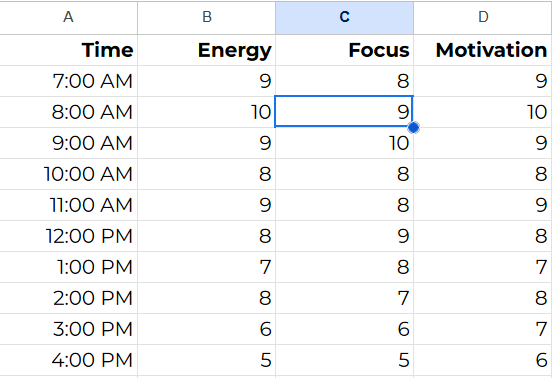The Rhythm of Productivity: How to Determine Your Peak Productive Hours
Energy, just like time, is a limited resource and therefore should be used just as wisely. Throughout the day, your productivity levels fluctuate. You may be more active in the morning or are better focused at night, hence why you often hear people referring to themselves as “early birds” or “night owls”. These terms are also called chronotype or, borrowing the term coined by productivity expert Chris Bailey, your biological prime time. If you want to take advantage of your peak energies during the workday, knowing your chronotype or biological prime time is key.
“The most productive people don't just manage their time well, they also manage their energy and attention well.” – Chris Bailey, Author of The Productivity Project
What are chronotypes
In simple terms, an individual's chronotype is their inherent tendency to feel more awake and alert during certain times of the day or night.
There are three main categories of chronotypes: the morning type, the evening type, and the neither type. These are categorized according to the body’s natural preferences for peak productivity hours.
- Morning types naturally wake early with peak productivity in the morning hours before a mid-afternoon slow burn. They are your classic morning larks.
- Evening types are night owls who struggle with mornings but hit their stride later, with their most productive hours and highest energy levels in the evening.
- Neither types have an in-between productivity rhythm, experiencing optimal focus and peak energy time in the mid-morning through mid-afternoon periods.
How to know your chronotype
You might already have a pretty good idea of your chronotype but in case you are unsure, it’s good to do an energy audit.
An energy audit is done by tracking your productivity and energy patterns for one to three weeks. At the end of this audit, you will know your personal chronotype and your most productive hours.
Before you begin: Cut down your caffeine and alcohol consumption to rule out chemically-induced bumps in energy levels. Bailey also recommends waking up without an alarm.
Next, use a scale of 1 to 10 (10 being the highest) to record your data for the following factors every hour for the next 3 weeks:
- Energy
- Focus
- Motivation
Here’s an example of what that might look like.

Using a digital spreadsheet, you can graph these numbers on a chart to get a better visual of what they mean. By doing so, you get a bigger picture of your energy fluctuations throughout the entire day.

The chart above suggests that this individual thrives in the morning hours. The data points to a peak in motivation, energy, and focus levels between 8 AM and 9 AM. They dip and slightly hike back up again until gradually tapering off as the day progresses.
While a single table and chart will already give you an idea of your chronotype, running the experiment for longer helps rule out day-to-day inconsistencies. By the end of this experiment, you can put all your data in a graph and see the overall trend of your focus, motivation, and energy levels.
If, after the experiment, you are still unsure about your chronotype, online assessments like the Morningness-Eveningness Questionnaire or Munich Chronotype Questionnaire can scientifically identify your chronotype category.
Factors that affect your productivity rhythm
One’s productivity rhythm is regulated by the body’s internal circadian rhythms or biological clocks. However, they are shaped by a few chronobiology factors. These include:
- Genetics. Your DNA makeup plays an innate role in determining your chronotype — whether you’re a morning lark or night owl by nature.
- Environmental factors like light exposure, lifestyle, and work schedules can reinforce or disrupt your natural chronotype and productivity patterns.
- Age-related factors. Your chronotype can change as you get older. You can be a morning type in your teenage years and become a night owl in your adulthood.
- Zeitgebers or external cues like meal times, exercise routines, and social obligations act as signals that reset your body clocks daily.
How to optimize your day for peak productivity
Strategies for morning chronotypes
1. Take a mid-afternoon break. Allowing yourself to recharge may help you sustain your focus even in the later hours of the day.
2. Leave the repetitive and monotonous work for the afternoon.
3. Avoid big lunches. Keep your mid-day diet light and rich in protein.
Strategies for evening chronotypes
1. Do the routine stuff in the morning.
2. Prepare everything the night before — your clothes, your bag, your to-do list, etc.
3. Sleep at the same time and avoid hitting the snooze.
4. Use natural light to wake you up in the morning.

Strategies for neither chronotypes
1. Take it slow in the morning — you don’t want to expend all your energy before you need it.
2. Prepare your snacks in case you’re in deep work during lunch hour.
Regardless of your chronotype, it's essential to prioritize self-care, take regular breaks, and maintain a healthy work-life balance to prevent burnout and sustain long-term productivity.
And remember, technology is your friend. Tools like TaskSpur can automate and prioritize your To-Do list so you can always focus on the work that matters; while an intelligent calendar assistant like Reclaim AI can schedule your focused work, important meetings, and even personal habits around your identified peak energy times, without the constant manual adjustments.
General tips for working with your chronotype
The following general tips will help you optimize your productivity regardless of your chronotype.
- Try the Pomodoro technique. Work in 25-minute focused bursts followed by 5-minute breaks, adjusting intervals to your energy levels.
- Design your environment. Use optimal lighting, minimize distractions, and curate a comfortable workspace. This will help enhance your productivity during your biological prime time.
- Establish habits and routines around sleep, meals, and exercise that reinforce your natural chronotype and keep your body clock running efficiently.
- If possible, choose jobs that allow you to work during your peak productivity hours.
Conclusion
In the end, discovering your chronotype and optimal biological prime time requires some self observation and experimentation. Pay close attention to your energy levels, cognitive abilities, and sleep patterns at different times of day over the course of a few weeks. Don't fight against your natural rhythms - instead, try to structure your day to align with the times when you are most productive and alert. With some adjustments, you can maximize your performance by scheduling demanding tasks during your personal prime time. Ultimately, we all have our own unique chronotype, so the key is tuning into your body's signals to unlock your most productive and high-energy hours.
Download TaskSpur on Android | Download TaskSpur on your iPhone
Sign up or Login on your browser
About the Author
Bernard Boodeea is the founder of Life Intelligence Group, a company that uses Agile principles to build products that help people succeed every day. Bernard is a seasoned certified Agile coach, entrepreneur, and technology consultant.
References
- chronotypes, sleep chronotype, what is a chronotype. (n.d.). Society of Behavioral Medicine. https://www.sbm.org/healthy-living/matching-behavior-and-biology-how-chronotypes-influence-your-physical-activity-and-sleep
- Morningness-Eveningness Questionnaire (MEQ) | QXMD. (n.d.). Calculate by QxMD. https://qxmd.com/calculate/calculator_829/morningness-eveningness-questionnaire-meq
- MCTQ. (n.d.). https://www.thewep.org/documentations/mctq
- Lebowitz, S. (2016, February 5). A productivity expert says this is the time of day when you should work on your most important tasks. Business Insider. https://www.businessinsider.com/productivity-expert-how-to-find-your-biological-prime-time-2016-2
- Khan, M. A. (2023b, September 6). Unlocking productivity for night owls and early birds. https://www.linkedin.com/pulse/indispensable-connection-personal-development-business-khan/
- Pacheco, D., & Pacheco, D. (2024, March 1). Chronotypes: Definition, Types, & Effect on Sleep. Sleep Foundation. https://www.sleepfoundation.org/how-sleep-works/chronotypes